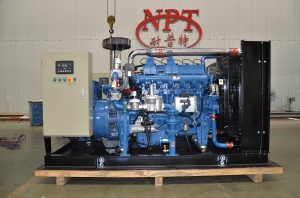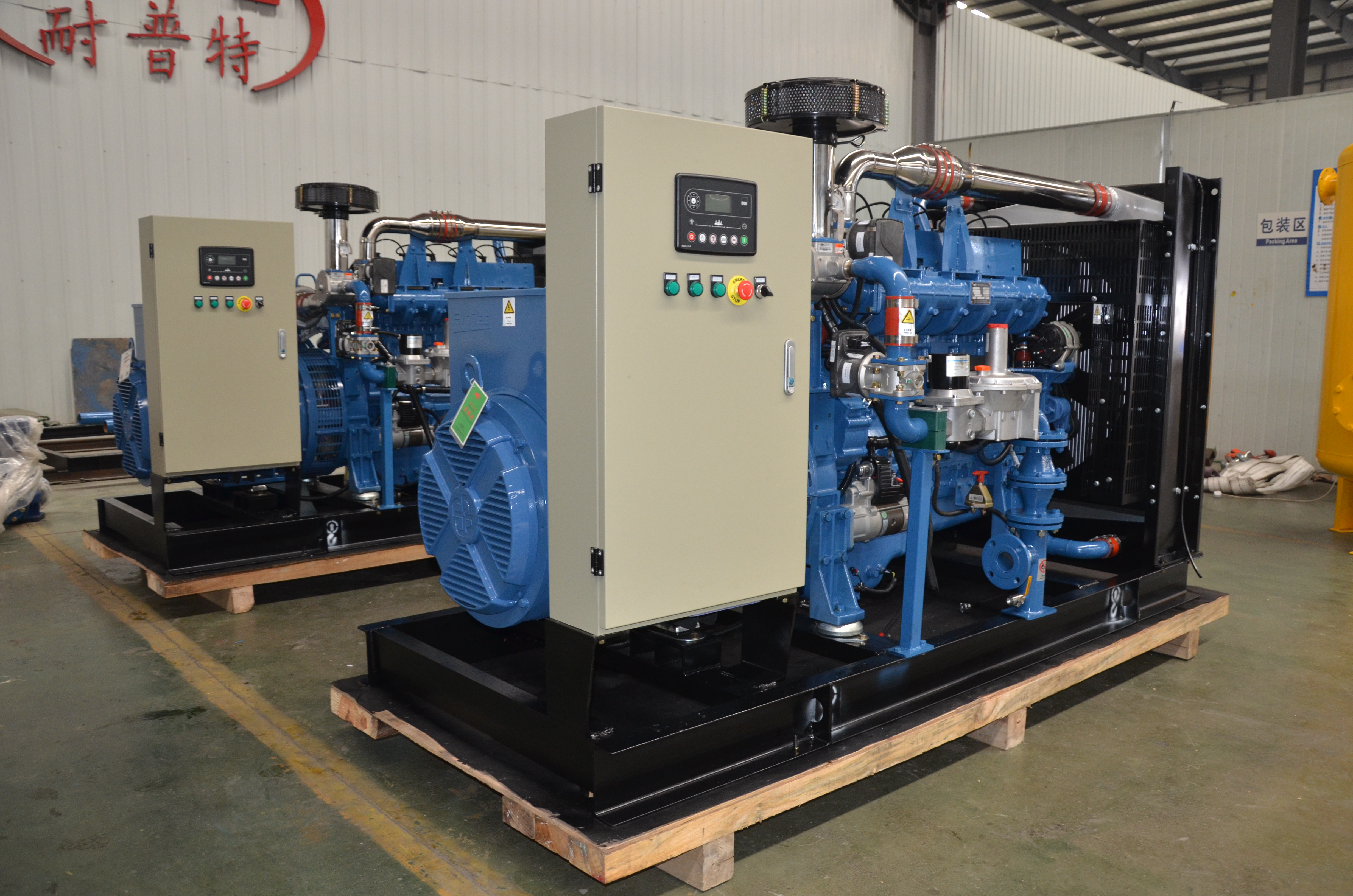 The working principle and advantages of a single-fuel biogas generator set: compress the mixture of “air biogas” in the cylinder, burn it with a spark plug, obtain power through the reciprocating motion of the piston, and then connect it to a generator to generate electricity.
The working principle and advantages of a single-fuel biogas generator set: compress the mixture of “air biogas” in the cylinder, burn it with a spark plug, obtain power through the reciprocating motion of the piston, and then connect it to a generator to generate electricity.
① No need for auxiliary fuel oil and its supply equipment
② The fuel is a system, which is simpler in control than a generator set that can burn two fuels
③ Lower price of generator set
The working principle and advantages of dual-fuel biogas-diesel generator set: compress the mixture of “air combustion gas” in the cylinder, burn it with ignition fuel, obtain power through the reciprocating movement of the piston, and then connect the generator to generate electricity.
① It can work with liquid fuel or gas fuel
② Can adapt to changes in biogas production and methane concentration
③ If the work is stopped when switching from gas fuel to diesel fuel, there will be no unburned gas left in the generator set, because it has good corrosion resistance.
Disadvantages of the two types of biogas generators: the work is affected by the quantity and quality of the biogas supplied
① Liquid auxiliary fuel is also needed when working with gas fuel
② Liquid fuel supply equipment is required
③ The control mechanism is slightly complicated
④ The price is slightly higher than that of a single-fuel generator set
Organic wastewater biogas generator set
What is organic wastewater
Organic wastewater is wastewater mainly composed of organic pollutants. Organic wastewater is likely to cause eutrophication of water quality and cause great harm. In industrial wastewater such as domestic sewage, food processing and papermaking, it contains organic substances such as carbohydrates, proteins, oils, and lignin. These substances exist in the sewage in a suspended or dissolved state and can be decomposed by the biochemical action of microorganisms. It needs to consume oxygen during its decomposition process, so it is called oxygen-consuming pollutant. This pollutant can reduce dissolved oxygen in water and affect the growth of fish and other aquatic organisms. After the dissolved oxygen in the water is exhausted, the organic matter undergoes anaerobic decomposition, producing unpleasant odors such as hydrogen sulfide, ammonia and mercaptans, which further deteriorate the water quality. The composition of organic matter in the water body is very complex. The concentration of oxygen-consuming organic matter is usually expressed by the amount of oxygen consumed during the biochemical decomposition of oxygen-consuming substances per unit volume of water, that is, expressed by the biochemical oxygen demand (BOD). It is generally expressed as the five-day biochemical oxygen demand (BOD5) at 20°C.
Main customer groups
Organic wastewater and biogas generator
Organic wastewater and biogas generator set
Organic wastewater biogas generator set
Key customer groups: paper mills, alcohol plants, starch plants, pharmaceutical plants, biochemical plants, etc.
At present, the cost of treating the “three wastes” in industrial production such as citric acid, alcohol, and paper mills is getting higher and higher. The “environmental protection storm” that began last year has made the work of treating the three wastes a life-or-death event for enterprises.
There are three main ways to control the “three wastes” in industrial production:
The first is to adopt reasonable and effective treatment methods for the “three wastes”;
The second is to improve the synthesis process to eliminate pollution in the production process;
The third is to make rational use of the “three wastes” and turn wastes into treasures.
To eliminate pollution fundamentally, the key is to carefully analyze and study every link and step that produces pollution, eliminate pollution in the process of production, and achieve cleaner production. In addition, it is necessary to vigorously develop waste comprehensive utilization technologies to increase the economic benefits of enterprises and ensure their competitive advantages. The “three wastes” we discuss here mainly refer to the organic wastewater. There are many sources of industrial organic wastewater, mainly from citric acid, sugar, alcohol, papermaking, aquaculture, PTA and other industries. At present, the mainstream way to treat sewage in these industries is to use biochemical methods for treatment. A large amount of biogas is generated during the treatment process. According to estimates, The production of one ton of citric acid can produce about 225 cubic meters of biogas, of which the methane content can reach about 60%. This kind of biogas is a very good fuel for power generation. Each cubic meter of biogas can generate 1.7 kilowatt-hours of electricity, which is very beneficial. The production of one ton of alcohol can produce 300 cubic meters of biogas, the methane content can reach 70%, and the calorific value is higher. Similar to other industries, the amount of biogas produced is considerable.Biogas generator set
The working principle and advantages of a single-fuel biogas generator set: compress the mixture of “air biogas” in the cylinder, burn it with a spark plug, obtain power through the reciprocating motion of the piston, and then connect it to a generator to generate electricity.
① No need for auxiliary fuel oil and its supply equipment
② The fuel is a system, which is simpler in control than a generator set that can burn two fuels
③ Lower price of generator set
The working principle and advantages of dual-fuel biogas-diesel generator set: compress the mixture of “air combustion gas” in the cylinder, burn it with ignition fuel, obtain power through the reciprocating movement of the piston, and then connect the generator to generate electricity.
① It can work with liquid fuel or gas fuel
② Can adapt to changes in biogas production and methane concentration
③ If the work is stopped when switching from gas fuel to diesel fuel, there will be no unburned gas left in the generator set, because it has good corrosion resistance.
Disadvantages of the two types of biogas generators: the work is affected by the quantity and quality of the biogas supplied
① Liquid auxiliary fuel is also needed when working with gas fuel
② Liquid fuel supply equipment is required
③ The control mechanism is slightly complicated
④ The price is slightly higher than that of a single-fuel generator set
Organic wastewater biogas generator set
What is organic wastewater
Organic wastewater is wastewater mainly composed of organic pollutants. Organic wastewater is likely to cause eutrophication of water quality and cause great harm. In industrial wastewater such as domestic sewage, food processing and papermaking, it contains organic substances such as carbohydrates, proteins, oils, and lignin. These substances exist in the sewage in a suspended or dissolved state and can be decomposed by the biochemical action of microorganisms. It needs to consume oxygen during its decomposition process, so it is called oxygen-consuming pollutant. This pollutant can reduce dissolved oxygen in water and affect the growth of fish and other aquatic organisms. After the dissolved oxygen in the water is exhausted, the organic matter undergoes anaerobic decomposition, producing unpleasant odors such as hydrogen sulfide, ammonia and mercaptans, which further deteriorate the water quality. The composition of organic matter in the water body is very complex. The concentration of oxygen-consuming organic matter is usually expressed by the amount of oxygen consumed during the biochemical decomposition of oxygen-consuming substances per unit volume of water, that is, expressed by the biochemical oxygen demand (BOD). It is generally expressed as the five-day biochemical oxygen demand (BOD5) at 20°C.
Main customer groups
Organic wastewater and biogas generator
Organic wastewater and biogas generator set
Organic wastewater biogas generator set
Key customer groups: paper mills, alcohol plants, starch plants, pharmaceutical plants, biochemical plants, etc.
At present, the cost of treating the “three wastes” in industrial production such as citric acid, alcohol, and paper mills is getting higher and higher. The “environmental protection storm” that began last year has made the work of treating the three wastes a life-or-death event for enterprises.
There are three main ways to control the “three wastes” in industrial production:
The first is to adopt reasonable and effective treatment methods for the “three wastes”;
The second is to improve the synthesis process to eliminate pollution in the production process;
The third is to make rational use of the “three wastes” and turn wastes into treasures.
To eliminate pollution fundamentally, the key is to carefully analyze and study every link and step that produces pollution, eliminate pollution in the process of production, and achieve cleaner production. In addition, it is necessary to vigorously develop waste comprehensive utilization technologies to increase the economic benefits of enterprises and ensure their competitive advantages. The “three wastes” we discuss here mainly refer to the organic wastewater. There are many sources of industrial organic wastewater, mainly from citric acid, sugar, alcohol, papermaking, aquaculture, PTA and other industries. At present, the mainstream way to treat sewage in these industries is to use biochemical methods for treatment. A large amount of biogas is generated during the treatment process. According to estimates, The production of one ton of citric acid can produce about 225 cubic meters of biogas, of which the methane content can reach about 60%. This kind of biogas is a very good fuel for power generation. Each cubic meter of biogas can generate 1.7 kilowatt-hours of electricity, which is very beneficial. The production of one ton of alcohol can produce 300 cubic meters of biogas, the methane content can reach 70%, and the calorific value is higher. Similar to other industries, the amount of biogas produced is considerable.
Post time: May-27-2021

